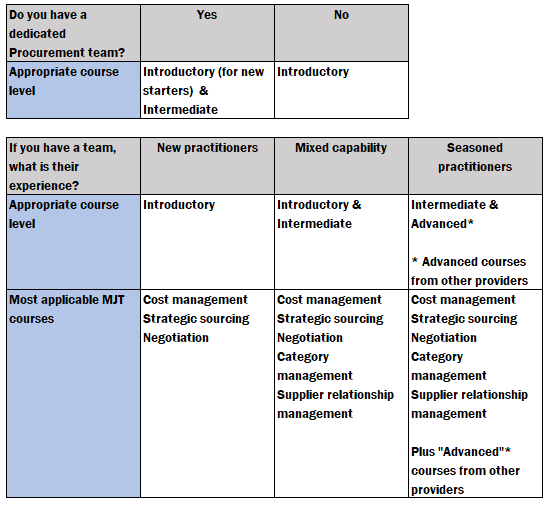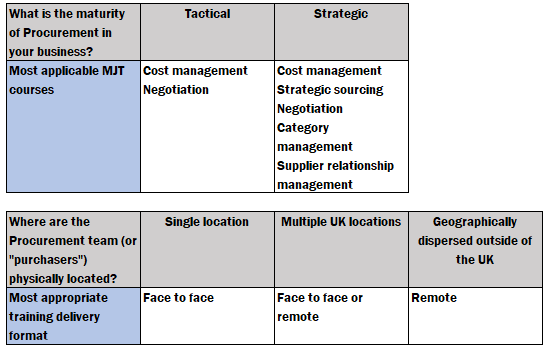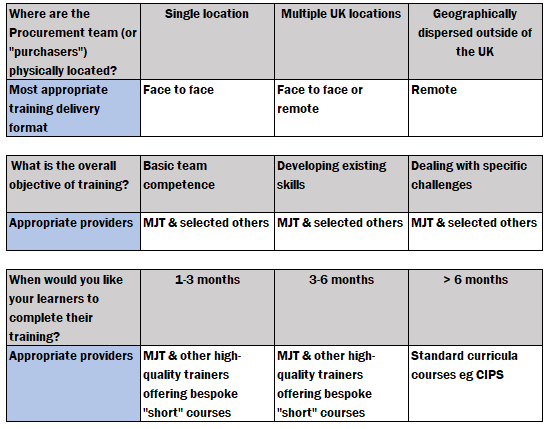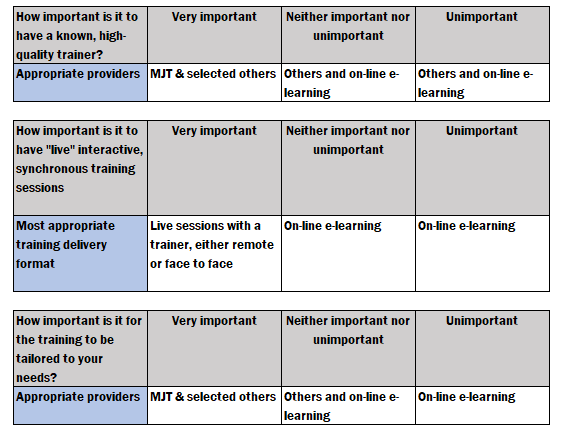There’s no straightforward answer to this question, so let me try and guide you through the 9 questions to ask yourself to find the best procurement training option for you. You can of course contact me to discuss here.
The good news is that there are a great choice of training providers, subjects, course formats and training delivery formats so that your needs can be catered for. Martin John Training (“MJT”) offers a range of bespoke Procurement courses, either face-to-face or “live”, on-line.
If you’re in Learning and Development or in Procurement, the best Procurement training course for your business will depend on several factors, so let’s start with a few of the main considerations.
1. Do you have a dedicated Procurement team?
If you don’t have a dedicated Procurement team then it could be the case that the buying of goods and services is handled by some individual “purchasers” using their best efforts, and who may have not had the benefit of specific Procurement training. Your business could therefore be missing out on cost reduction and risk mitigation benefits. The good news is that providing them with some introductory Procurement training can bring significant business results in short order.
2. What is the experience level of the Procurement or “purchasers” team?
If your team is new or if the team of purchasers are practicing as an add-on to their day job, they’re more likely to benefit from introductory level courses. If your team is of mixed experience, then both introductory courses combined with intermediate courses could suit. Experienced Procurement teams are more likely to require advanced courses.
3. Does Procurement operate at a tactical or strategic level in your business?
This is an important factor. Teams that operate in a tactical environment have different needs to those operating in a strategic environment, where the former are likely to benefit from cost management and negotiation expertise, while teams operating strategically are likely to require more sophisticated training such as category management and supplier relationship management.
4. Where are those responsible for the buying of goods and services physically located?
A face-to-face course will be more readily achievable with co-located teams. This offers the ease of holding plenary discussions and the benefits associated with synchronous learning Notwithstanding this, remote, live training can be very effective, especially with a trainer experienced with delivery of this format. For a detailed look at the pros and cons of remote learning, click here.
5. What is the overall objective of the training?
Occasionally this aspect is overlooked, but training is NOT always the answer! However, training can be used as a means to achieve many objectives such as; generally upskilling the team, addressing specific skills gaps, tackling a specific corporate challenge or to equip the team with formal qualifications.
6. When would you like your learners to complete their training?
There’s no denying the rigor, scholarly depth or reputation of formal CIPS learning (or qualifications from other professional bodies) but the downside of these courses is that they can be costly (especially if multiple members of your team are studying) can take a long time to complete and hence the benefit of this training may not be realized in an acceptable time frame.
However, if you’d prefer “rapid-response”, practical courses that provide the learners with the necessary skills and tools they need to make an impact to your business straight away, then a “short” course could be the best option for you.
Simply, the delivery of a “short” course can be conducted within a period of 1 to 3 months depending on group size, and live on-line courses offer the advantage of being able to be broken down into multiple bite-sized sessions. Several “short” courses can be delivered within 3-6 months, depending on group size.
7. How important is it for you to have a high-quality trainer?
The market for trainers is very broad, and as you’d expect there are trainer options across the full quality spectrum. If high quality is important to you, try to find a trainer who has experience of what they’re teaching, can bring the subject to life, is interactive and engaging, and who is presenting their own material (rather than reading material prepared by others). Many high-quality trainers will have videos on YouTube so that you can view their delivery and engagement style in advance.
8. How important is it for you to have “live” synchronous training sessions?
There is a panoply of pre-recorded e-learning available across a multitude of topics and this might be suitable for your needs. E-learning can be asynchronous and can be viewed multiple times (which scores high on convenience but can be a little “dry” and therefore less memorable). A live, synchronous experience with other team members (whether face-to-face or virtual) offers more discussion, debate and a broader exploration of the topic. This format is certainly more fun, engaging and memorable, too.
9. How important is it for training sessions to be tailored to your needs?
E-learning options are mostly a standard “off-the-shelf” option, permitting very little, if any bespoke elements. Qualification courses from professional bodies also follow standard curricula. If you require courses to be tailored to the needs of your business, or to address a specific business topic, then live courses from quality independent training providers may be best suited to your needs.
The above is all summarized in the table below.




I hope that this guide has been helpful for you in trying to define the best type of Procurement training for your business. If you would like to discuss Procurement training with me, please contact me here.
The best days lie ahead
Martin